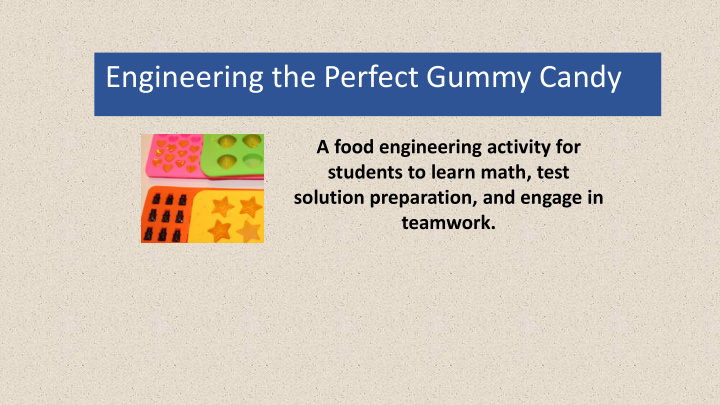



Engineering the Perfect Gummy Candy A food engineering activity for students to learn math, test solution preparation, and engage in teamwork.
How are these items related? Can you match the items with the pictures? Jell-O hydrobeads contact lens ketchup gel pad gummy candy
Background: Hydrogels • S ometimes known as “aqua gels” • Belong to a unique group of nano-polymers • Hold large quantities of water in a three-dimensional “lattice” that encase the substances into a solid • Occur both naturally, as in collagen, and synthetically, as in powdered gelatin • Changes in shape depending on the environment
Hydrogels: Solid-Liquid State Hydrogel
Activity: Calculations and Procedure
Gummy Bear Candy Ratio • Recipe proper ratio: • Calculate the conversion factor to • 1 cup pure 100% juice, prepare the volume needed to fill no sugar added the molds. • 2 tbsp unflavored gelatin • Calculate the ratio to scale the amount of product to fill the mold.
Edible Hydrogel Instruments with heat, • When temperature reaches ~30 ° C, temperature control, and add small amounts of the gelatin a magnetic stirrer used to powder into the warm juice. prepare hydrogel gummy candy. • Heat the juice until its very warm (~37 ° C - ~48 ° C) but not boiling. • If the liquid is too hot, it could break down the gelatin protein and your gummies may not set.
Edible Gummy Solutions Placed into Molds • Add hydrogel solutions to silicon candy molds. • Carefully place the molds on a metal oven tray on top of ice in a cooler and chill for about 20 minutes. • Or, position molds on a paper plate and place in a refrigerator and chill at 0-4°C for 20-40 minutes. Students prepare edible hydrogels using varied concentrations of gelatin in beet, apple and orange juice.
Discussion Post Activity: Why does the weight of gelatin and volume of juice effect how the • hydrogel formed? Why should the dry ingredients such as gelatin be added into the juice • instead of adding the juice to a beaker of dry gelatin? What might happen if the ingredients were not thoroughly mixed? • What would happen if the temperature of the juice varied? •
YouTube Videos Kara Spiller. Biomaterials Lecture - Natural polymers and hydrogels https://www.youtube.com/watch?v=gxGeK4rzEr0 Mitch Plumley. Hydrogel Polymers https://www.youtube.com/watch?v=BE1xk1rlrGg ALIwebsite. Occupational Video - Food Scientist https://www.youtube.com/watch?v=tweElJtj3o8
Recommend
More recommend